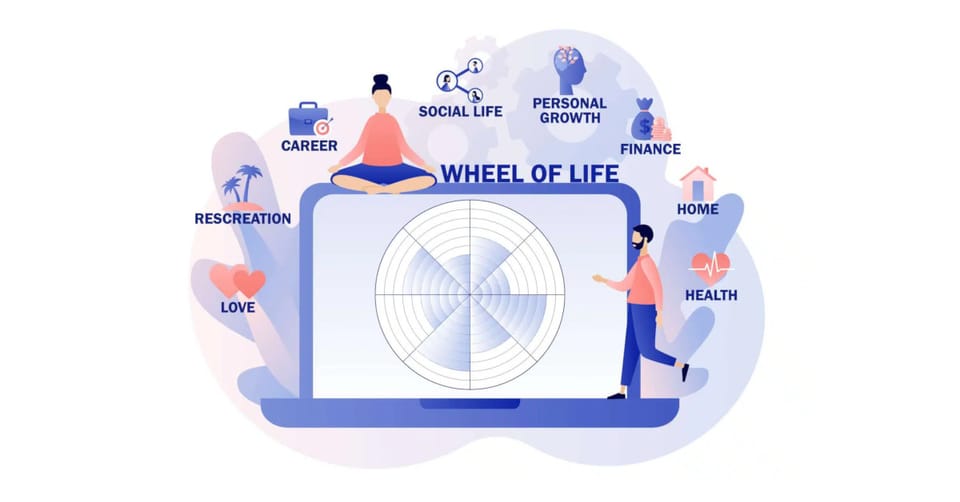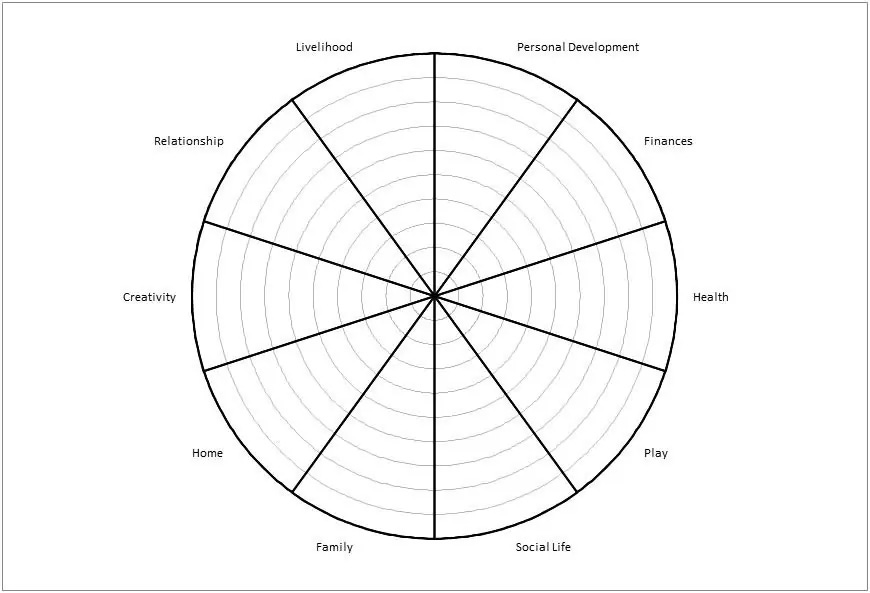Using a Wheel of Life to Guide Personal Growth

We all have times when life feels out of control.
Schedules become overcrowded with work, family commitments, kids’ activities, side projects, and hundreds of other things. The overload causes stress and overwhelm that impacts our quality of life.
Thanks for reading! Subscribe for free to receive new posts and support my work.
We can get caught up in the chaos and forget our goals or how we want to live. Each day drifts into the next, then suddenly, months have passed, but we haven’t made any progress.
Getting back on track requires a system that helps us to remove sources of friction, prioritize areas for improvement, and monitor the results of our actions. A solid system can help us avoid overwhelm, stay focused, reduce stress, and achieve our goals.
I developed my own system in response to challenges in my life. It’s not perfect, but it will keep evolving.
The first step is to stop and assess your current situation.
Establishing this baseline helps you find a starting point so you can measure the results as you make changes.
As the famous Gen-X philosopher Ferris Bueller says:
Life moves pretty fast. If you don’t stop and look around once in a while, you could miss it.
- Ferris Bueller’s Day Off
Sounds great, but how do we do that?
We need a simple tool that allows us to easily scan the different areas of our lives.
Areas of Life
I learned to compartmentalize1 things as a coping mechanism when I was a kid.
After my parents divorced, my mother often worked two jobs to support my brother and me. The stress and financial strain made focusing on school and enjoying time with friends challenging.
Things improved when I learned the skill of compartmentalization. It allowed me to separate my life into different aspects like school, sports, hobbies, friends, and family, preventing the tough times from overshadowing the good ones.
I outgrew the need for strict separations in my life, but I found some value in that approach. Life is a blend of different areas that intersect and flow together through give and take.
My life was more complex now. I needed a simple tool that allowed me to quickly assess how I was doing and figure out where to focus my attention.
The Wheel Of Life
An ancient tool called the wheel of life is a visual representation of the different areas of life. It looks like a wheel with spokes dividing it into multiple sections such as health, finances, relationships, personal growth, etc.
I discovered this tool while deployed in the Middle East during Operation Desert Shield/Desert Storm. I’d been reading ancient philosophy books like Plato’s Republic, the Tao Te Ching, and The 3 Pillars of Zen.
The Buddhist concept of the wheel of life grabbed my attention because it resonated with me.
A practical application of this concept is a diagram of a circle divided into sections like a pie. Each section represents an area of your life, such as health, finances, relationships. There are many variations on this theme from ancient Eastern teachings to modern personal development writers like Zig Ziglar and Michael Hyatt.
2Zig Ziglar, the famous motivational speaker, described a wheel of life with seven spokes: mental, spiritual, physical, family, financial, personal, and career. However, the model is flexible and personal. Author Michael Hyatt3, shared his interpretation in his Life Assessment Tool.
Using a wheel of life can help compartmentalize things when life gets busy. It can also help keep things in perspective when you look at the areas relative to each other. For example, if you’re struggling with finances and it is a low scoring area for you, you can check it against your relationships or other areas. It’s unlikely that every area of your life is in a low state at the same time.
Comparing the areas of your life might help you realize that you are doing well in several areas even though a couple might need work. The wheel of life model can help you determine where to spend your time and effort to improve your life. It will also allow you to track your progress over time.
Creating my personal wheel of life helped me figure out which areas were on track and which needed more attention.
To create your wheel of life diagram, follow these instructions:
- Think about your life and make a list of 5-10 areas that you identify as the main categories (i.e., health, work, relationships, finances).
- Draw a circle and divide it into as many slices as you need to represent the areas of your life.
- Draw a line from the center of the circle through each area (slice) to the edge of the circle.
- Make 9 equally spaced hash marks on the line with the 10th being the edge of the circle.
- Number the hash marks 0 to 10 from the center of the circle (the center is 0 for all areas)
- Some models use 10 concentric circles instead of a number line to rate the level of success in each area.
- Label each slice of the pie as an area of your life.
To use your wheel of life, follow these instructions:
- Think about how you are doing or how you feel about each area of your life, then rate it 0-10 with 10 being the highest.
- Mark your score for each area and color the area from center to your mark. Use a different color for each area of life.
- Your wheel of life will look similar to the image below.

When you finish creating your wheel of life, you’ll have a visual diagram of the current status of the different areas of your life. The higher shaded sections indicate areas of greater success. The lower shaded sections indicated areas of your life that have room for improvement. These become your target areas.
After you’ve determined which area you’d like to improve first, it’s time to drill down to find sources of friction in that area.
Sources of friction are things that hold you back or work against your ability to make progress. For example, bad habits or lack of attention to detail can keep you from reaching your goals.
💡Pro Tip:
Use the same colors from your wheel of life to assign task list items and calendar events to areas of your life. This will help you assess whether your actions and commitments are aligned with the areas of life that need more attention.
You can monitor your success as you make changes by updating your wheel of life during scheduled reviews. Using this tool and the system described above will help you take the first step in making progress toward a more balanced life.
Thanks for reading! Subscribe for free to receive new posts and support my work.
References
Ohwovoriole, T. How to Compartmentalize to Reduce Stress. Verywell Mind Blog. ↩
Zig Ziglar’s Wheel of Life at [https://www.ziglar.com/articles/the-wheel-of-life/] ↩
Michael Hyatt Life Assessment Tool at [https://assessments.michaelhyatt.com/lifescore/] ↩




